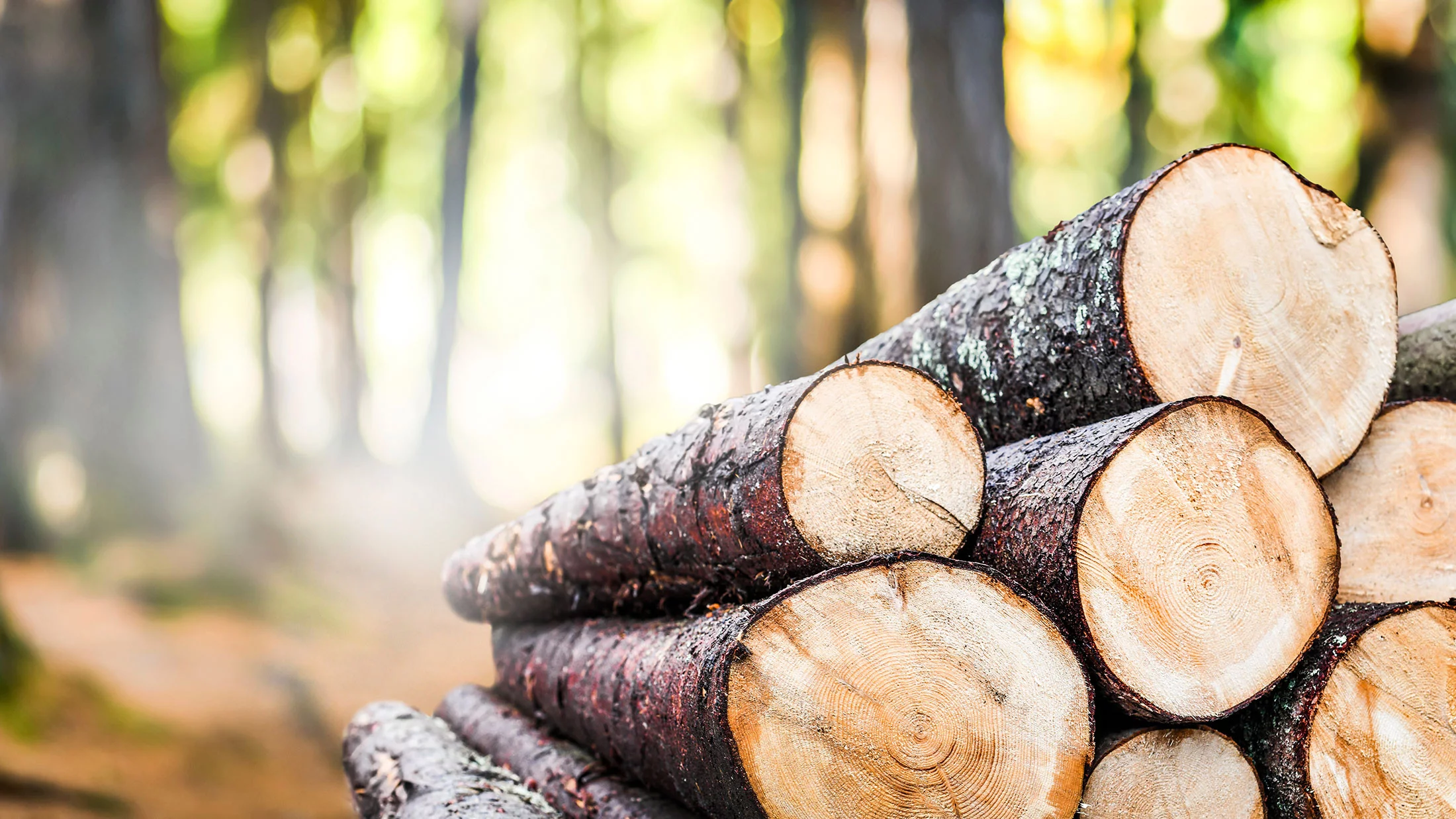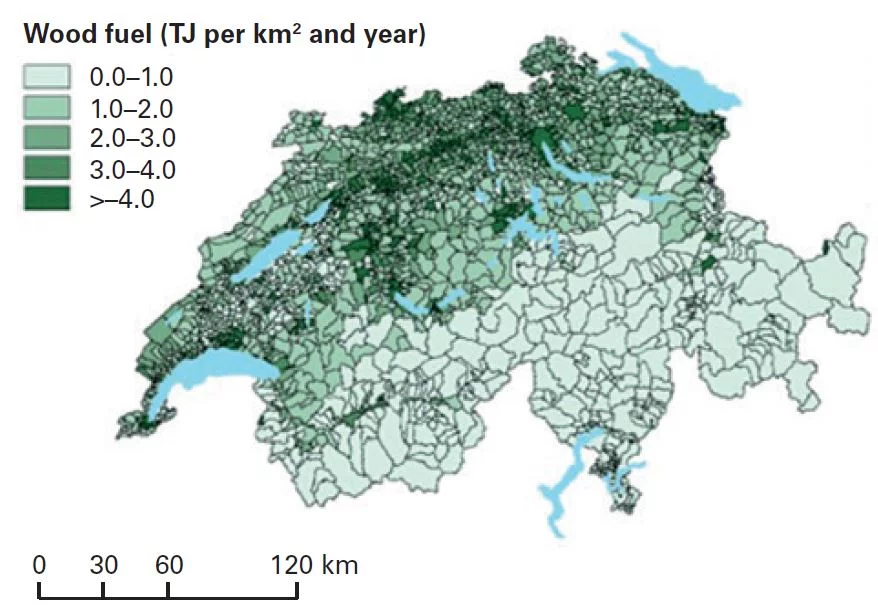Wood is a trump card for the energy transition because it is very versatile and easy to store. Compared to today, up to a third more energy could be obtained from wood, not only in the form of heat, but also in the form of electricity and fuels. However, current use is not efficient enough, Swiss bioenergy researchers have shown in a new report.
Wood can be produced CO2 neutrally, used several times as a material, transported and stored in various forms, and used as heat, electricity and fuel. Last but not least, it can bridge gaps in solar and wind energy production, as it is available all year round. Researchers at the Swiss Federal Institute for Forest, Snow and Landscape Research WSL, the Paul Scherrer Institute PSI and other institutions have calculated the energy potential of Swiss wood and further developed technologies for combustion and conversion into electricity and fuels. They also investigated how bioenergy should best be embedded in the Swiss energy system.
The authors of the "White Paper Wood" emphasise that "energy wood is of greater importance than its comparatively low potential would suggest". It summarises the results of the Federal Government's multi-year energy research programme "Biomass for Swiss Energy Future" (SCCER Biosweet), which involved up to 15 research groups and dozens of industry partners.
Unused but limited potential
Currently, wood energy accounts for about 5 per cent of the total final energy consumption in Switzerland, namely about 40 petajoules (PJ) per year. That is slightly more energy than the city of Zurich needs in a year. This share could - economically and ecologically sustainable - increase by a maximum of one third (14 petajoules), calculated the WSL bioenergy experts.
Energy wood can originate directly from the forest and open land, but it can also be residual wood from carpentry and sawmills or wood that has already been used (referred to as waste wood). The most untapped potential (5 to 10 PJ) remains in forest wood. "Wood as a valuable but limited source of energy requires efficient use," emphasises Oliver Thees from WSL, who played a leading role in the report.
The researchers suggest the following for more efficient use: From a climate protection perspective, wood should not go straight from the forest into the oven, if possible. Instead, it should first be used to make houses and furniture, chipboard or insulating materials before it is burned. This is called cascade use. At present, however, 95 per cent of the valuable energy wood is used to generate heat for heating rooms. This is not optimal, the authors warn.
Aircraft that fly with wood
For maximum energy production and CO2 savings, wood should be used differently on a larger scale than it is today. In industry, wood can be used to generate high-temperature process heat, for example in the form of steam. Or it can be used to produce gaseous and liquid fuels - including for aircraft. The waste heat and CO2 produced during conversion should be captured and used. This helps the CO2 balance and compensates for other emissions, such as those from agriculture, which are unavoidable. The conversion technologies developed in the research programme improve the efficiency and CO2 balance of such applications, but not all are ready for the market.
Furthermore, electricity can be generated from energy wood in combined heat and power plants, which would be the next best use, especially in winter, to bridge the winter electricity gap. If space heating is to be obtained from wood, this should ideally and if possible be done in large plants connected to the district heating network. These can be operated with fewer pollutants and more efficiently than a large number of small units. "We have developed new processes for converting wood into fuels and energy and brought them closer to the market, thus contributing to the success of the Swiss energy transition," says Oliver Kröcher from the Paul Scherrer Institute PSI, co-author of the report.
Stabilising the electricity grid
Because energy wood can be used in so many ways, the authors of the report call it a "wild card for shaping the energy transition". Their calculations also show that energy wood can stabilise the energy supply and the electricity grid, as wood can be stored and converted when needed to balance peak loads in the grid.
More efficient wood use will not come about by technological means alone. There is still work to be done in research, business and politics: The wood usage chains must be examined and optimised. There is a need for a basis for the practical implementation of these complex technologies. Last but not least, political measures can steer the use of wood, for example through targeted incentives for efficient combustion plants.
Text : Oliver Thees, Beate Kittl
About the White Paper Wood
The aim of this white paper is to provide decision-makers with the current research results in order to promote the optimal use of bioenergy from wood, as well as from some other solid biomass types in the Swiss energy transition. For this purpose, results of the Swiss Competence Centre for Bioenergy Research (SCCER BIOSWEET) are summarised and presented in a broader context regarding the state-of-the-art in research and its implementation in practice. If not specified otherwise, the results refer to Switzerland and, in the case of feedstock, to the domestic biomass potential.
The work was carried out by six Swiss research institutions in close cooperation with industry and under the leadership of the Paul Scherrer Institute PSI and was funded by the Swiss innovation agency Innosuisse. The "White Paper Wood" summarises the most important results and places them in the context of the current state of knowledge. It is available in German, French and English (original).
Further Information
Interactive map of forest energy wood EPS (German only)
Contact
Prof. Oliver Kröcher
Head of the Laboratory for Bioenergy and Catalysis
Paul Scherrer Institute, Forschungsstrasse 111, 5232 Villigen PSI, Switzerland
Telephone: +41 56 310 20 66, e-mail: oliver.kroecher@psi.ch
Dr. Vanessa Burg
Forest Resources and Management Sustainable Forestry
Swiss Federal Research Institute WSL, Zürcherstrasse 111, 8903 Birmensdorf, Switzerland
Telephone: +41 44 739 23 76, e-mail: Vanessa.burg@wsl.ch
Dr. Oliver Thees
Forest Resources and Management Sustainable Forestry
Swiss Federal Research Institute WSL, Zürcherstrasse 111, 8903 Birmensdorf, Switzerland
Telephone: +41 44 739 24 57, e-mail: oliver.thees@wsl.ch
Original publication
White paper – Wood fuel in Switzerland: energy potential, technology development, resource mobilization, and its role in the energy transition
Thees, O.; Erni, M.; Burg, V.; Bowman, G.; Biollaz, S.; Damartzis, T.; Griffin, T.; Luterbacher, J.; Marechal, F.; Nussbaumer, T.; Schildhauer, T.; Schweier, J.; Studer, M.; Kröcher, O.
SCCER-BIOSWEET; Birmensdorf, Swiss Federal Research Institute WSL, April 2023
DOI: 10.55419/wsl:32791
Copyright
PSI provides image and/or video material free of charge for media coverage of the content of the above text. Use of this material for other purposes is not permitted. This also includes the transfer of the image and video material into databases as well as sale by third parties.


